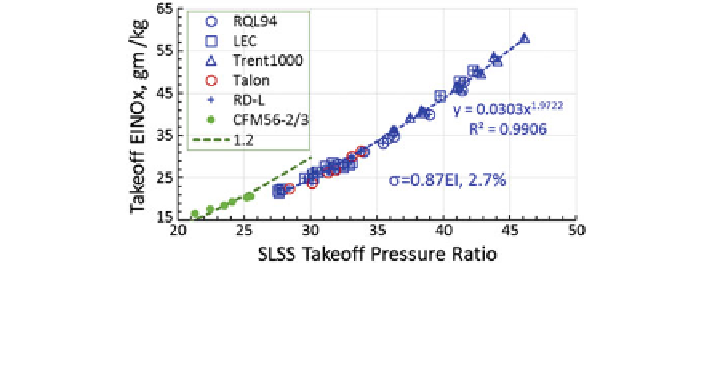Environmental Engineering Reference
In-Depth Information
takeoff NO
x
(see Fig.
7
), and idle HC as a function of idle CO (Mongia
2013a
,
b
,
c
).
Consequently, very interesting conclusions emerge as summarized in Fig.
13
which
shows that several of the recent large rich-dome engines produced by GE, P&W, and
RR have very similar characteristics in terms of the takeoff EINO
x
versus SLSS
takeoff pressure ratio. The resulting empirical correlation identi
ed by the legend
0303PR
1
:
9722
2
RD-L in Fig.
13
EINO
xRD
L
¼
0
:
w
=
R
¼
0
:
9906 gives good agree-
2
= 0.9906, root-mean-square
ment with the data; namely the correlation coef
cient R
errors (
) of 0.87 g/kg and 2.7 % which is comparable with the measurement
repeatability as determined by the average standard deviation of the LTO NO
x
.
Figure
13
also shows takeoff NO
x
emissions of the CFM56-2/3 engine family to
which belongs the engine tested by Bulzan et al. (
2010
); its combustion ef
˃
ciency
data was presented in Fig.
11
with more to follow in Figs.
38
,
39
and
40
for NO
x
and
particulate emissions along its SLS engine operating line. It is interesting to see that
takeoff NO
x
of the CFM56-2/3 tested in 1983 is approximately 20 % higher than the
best group of rich domes including Trent1000 tested in 2009, as shown by the dotted
green curve which represents 1.2 time RD-L values. The author is hopeful that the
N + 1 generation GTF TALON-X combustor will show signi
cant lower takeoff
NO
x
than RD-L. Otherwise, we will have to conclude that rich-domes takeoff NO
x
levels have settled down to the entitlement level given by the empirical correlation
EINO
xRD
L
¼
0303PR
1
:
9722
:
w
=
R
2
:
9906 and that it is only17 % lower than
the CFM56-2/3 engine tested in 1983; albeit we have learned to scale up from
25
-
45 OPR engines during the last 30 years.
We should be interested in estimating mission NO
x
emissionswhich depends on
the knowledge of engine operating points (viz. P
3
, T
3
, and fuel
0
¼
0
fl
flow rates) along the
airplane
flight path. We rely on engine performance models and weather conditions
to make accurate predictions for the fuel burn; it will be equally desirable to have
simple models for mission NO
x
calculations as discussed next.
fl
Fig. 13 Combined large rich-dome technology of GE, P&W, and RR identi
ed as RD-L showing
takeoff EINO
x
plotted as a function of SLSS takeoff pressure ratio; also shown the CFM56-2/3 and a
dotted green curve showing 1.2
×
RD-L trendline line which is given by EINO
xRD
L
¼
0
:
0303 OPR
1
:
9722

Search WWH ::

Custom Search